Create an Active-Active database
Shows how to create an Active-Active database
Active-Active databases store data across multiple regions and availability zones. This improves scalability, performance, and availability, especially when compared to standalone databases. See Active-Active Redis for more information.
To deploy Active-Active databases in Redis Cloud, you need a Redis Cloud Pro plan that enables Active-Active Redis and defines the regions for each copy of your databases.
Active-Active databases consist of multiple copies (also called instances) deployed to different regions throughout the world.
This reduces latency for local users and improves availability should a region fail.
Redis Cloud maintains consistency among instances in the background; that is, each copy eventually includes updates from every region. As a result, memory limit and throughput increase.
Create an Active-Active database
Before creating a Redis Cloud database, you need to create an account.
To create a database in your Redis Cloud account:
-
Sign in to the Redis Cloud console.
-
Select the New database button.

This displays the Create database screen.
-
Select your Redis use case. There are four pre-defined use cases:
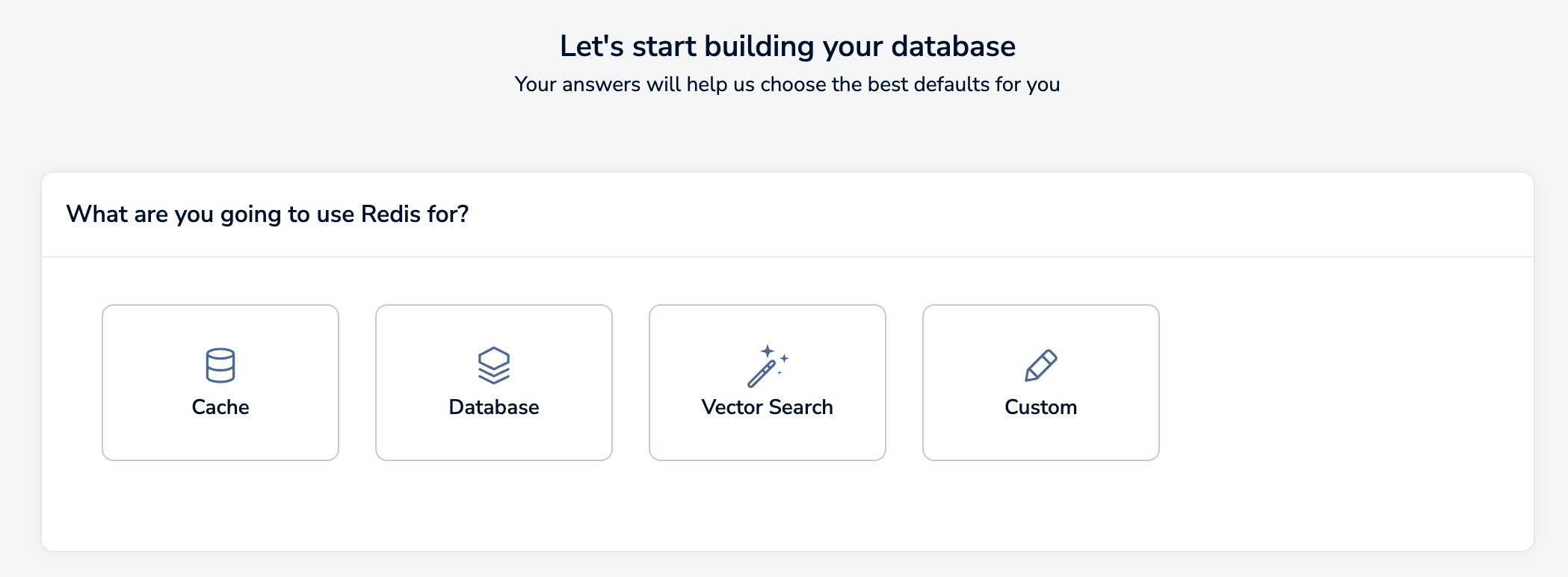
- Cache: Stores short-term or volatile data. Can be used for session management, semantic cache, session store, and other uses where data is short-lived.
- Database: Stores durable and consistent data. Can be used for document databases, feature storage, gaming leaderboards, durable caches, and other uses where your data needs to be highly available and persistent.
- Vector search: Manages and manipulates vector data. Can be used for Generative AI, recommendation systems, visual search, and other uses where you can search and query your data.
- Custom: If your Redis use case doesn't match any of the other use cases, you can choose this option to customize all of your settings.
Select the use case that best matches your Redis use case. You can always change the settings later.
-
Select the type of subscription you need. For this guide, select Pro.
 Note:This guide shows how to create an Active-Active database with a new Pro subscription. If you already have an Active-Active subscription and want to add a database to it, see Create a Pro database in an existing subscription.
Note:This guide shows how to create an Active-Active database with a new Pro subscription. If you already have an Active-Active subscription and want to add a database to it, see Create a Pro database in an existing subscription.
After you select Pro, you need to:
-
Set up the deployment options, including cloud vendor and region details for each instance.
-
Define the database size requirements.
-
Review your choices, provide payment details, and then create your databases.
The following sections provide more information.
Set up deployment details
The Setup tab specifies general settings for your Redis deployment.

There are three sections on this tab:
- General settings include the cloud provider details and specific configuration options.
- Version lets you choose the Redis version of your databases.
- Advanced options define settings for high availability and security. Configurable settings vary according to cloud provider.
General settings
Select Active-Active Redis to turn on Active-Active.
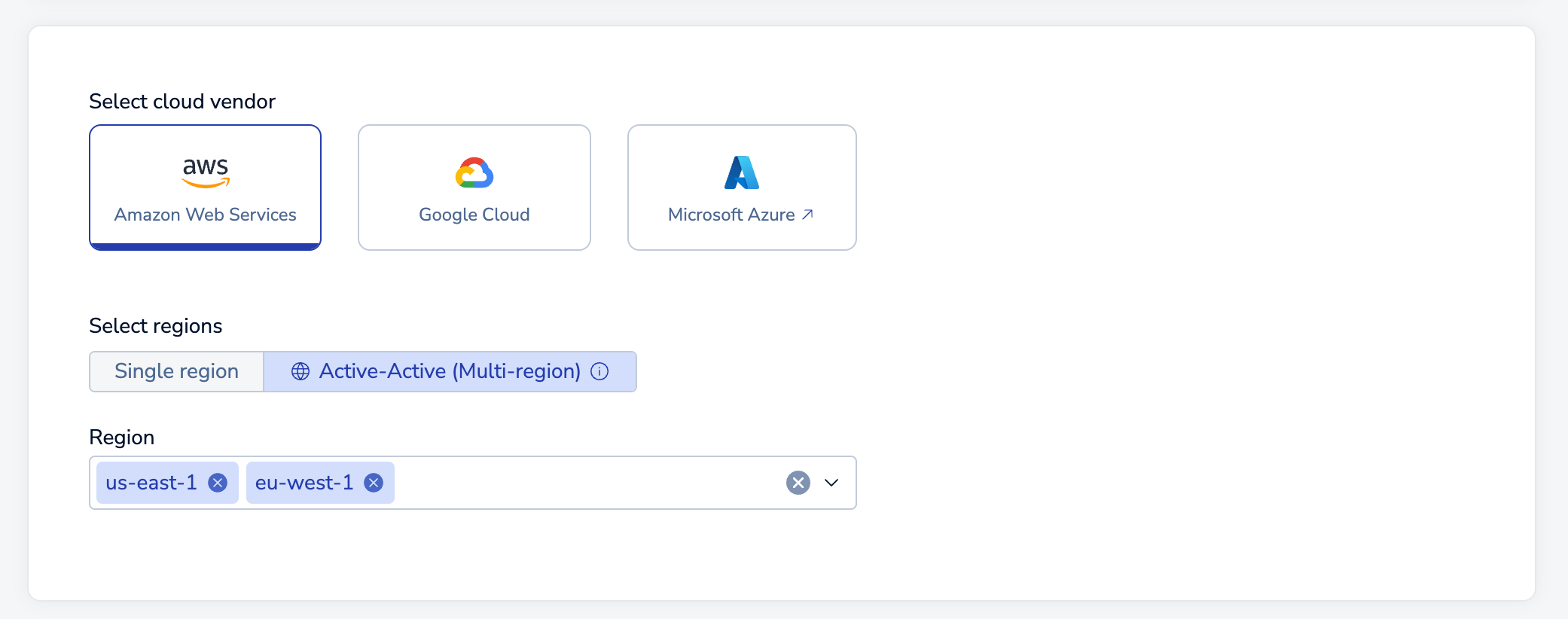
When you enable Active-Active Redis, two regions are selected by default. Select the drop-down arrow to display a list of provider regions that support Active-Active databases.
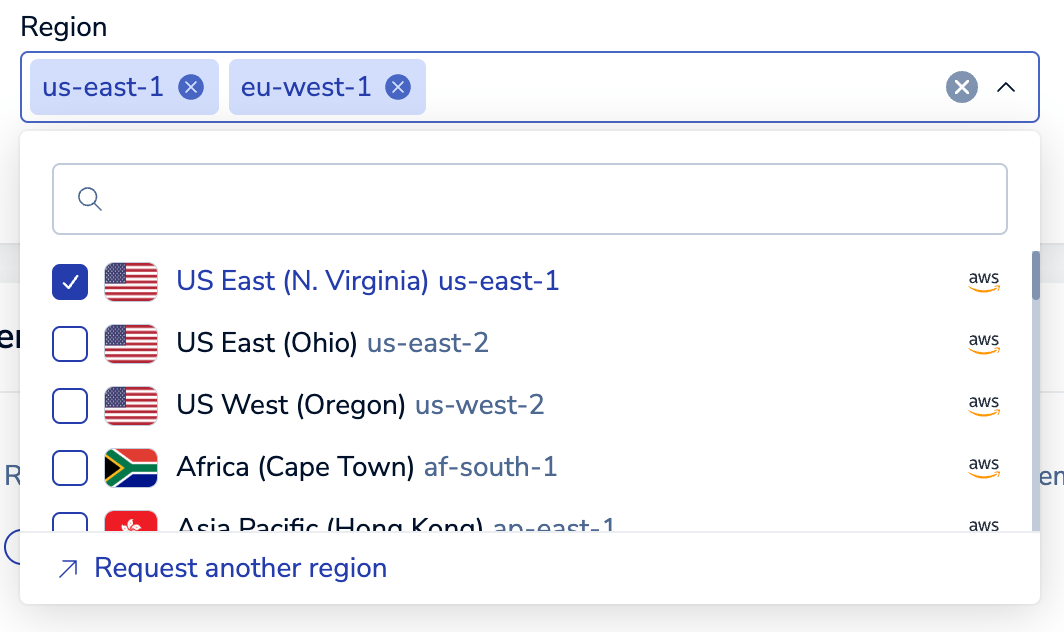
Use the checkboxes in the list to select or remove regions. The Search box lets you locate specific regions.
You can use a region's Remove button to remove it from the list.
Version

The Version section lets you choose the Redis version of your databases. Choose Redis 7.2 if you want to use the latest advanced features of Redis.
Advanced options
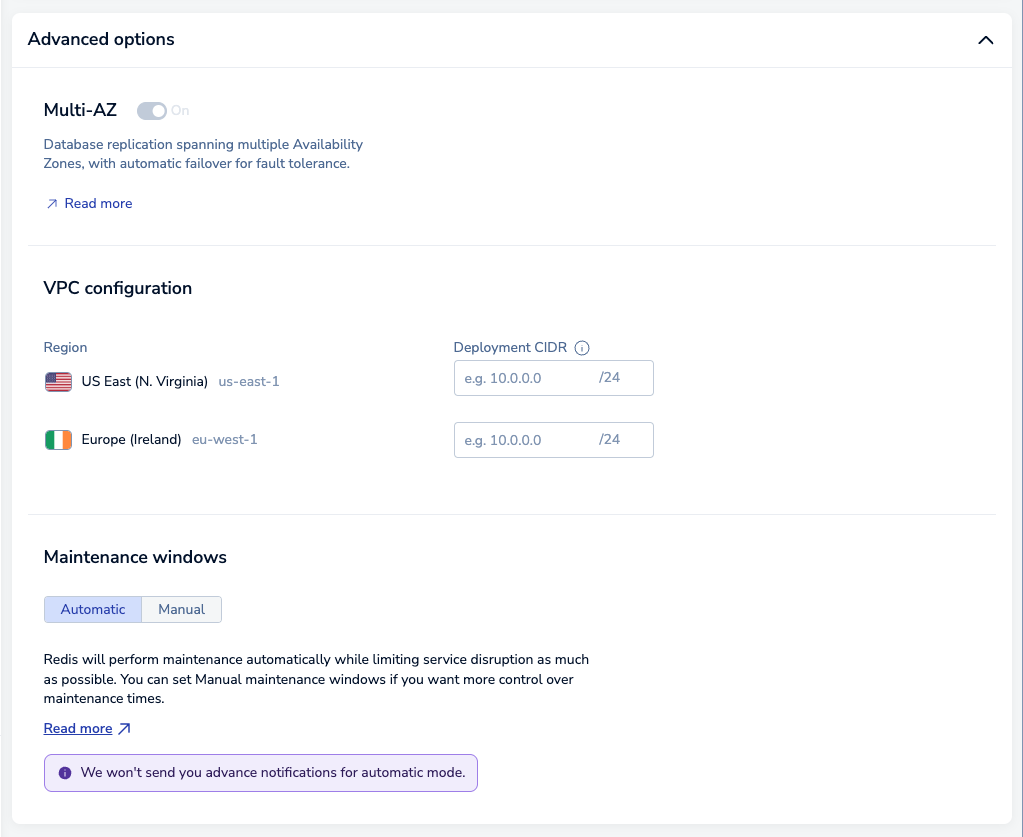
In the Advanced options section, you can:
-
Define CIDR addresses for each region in the VPC configuration section.
Every CIDR should be unique to properly route network traffic between each Active-Active database instance and your consumer VPCs. The CIDR block regions should not overlap between the Redis server and your app consumer VPCs. In addition, CIDR blocks should not overlap between cluster instances.
When all Deployment CIDR regions display a green checkmark, you're ready to continue.

Red exclamation marks indicate error conditions; the tooltip provides additional details.

-
Set your maintenance settings in the Maintenance windows section. Select Manual if you want to set manual maintenance windows.
When finished, choose Continue to determine your size requirements.

Sizing tab
The Sizing tab helps you specify the database, memory, and throughput requirements for your subscription.
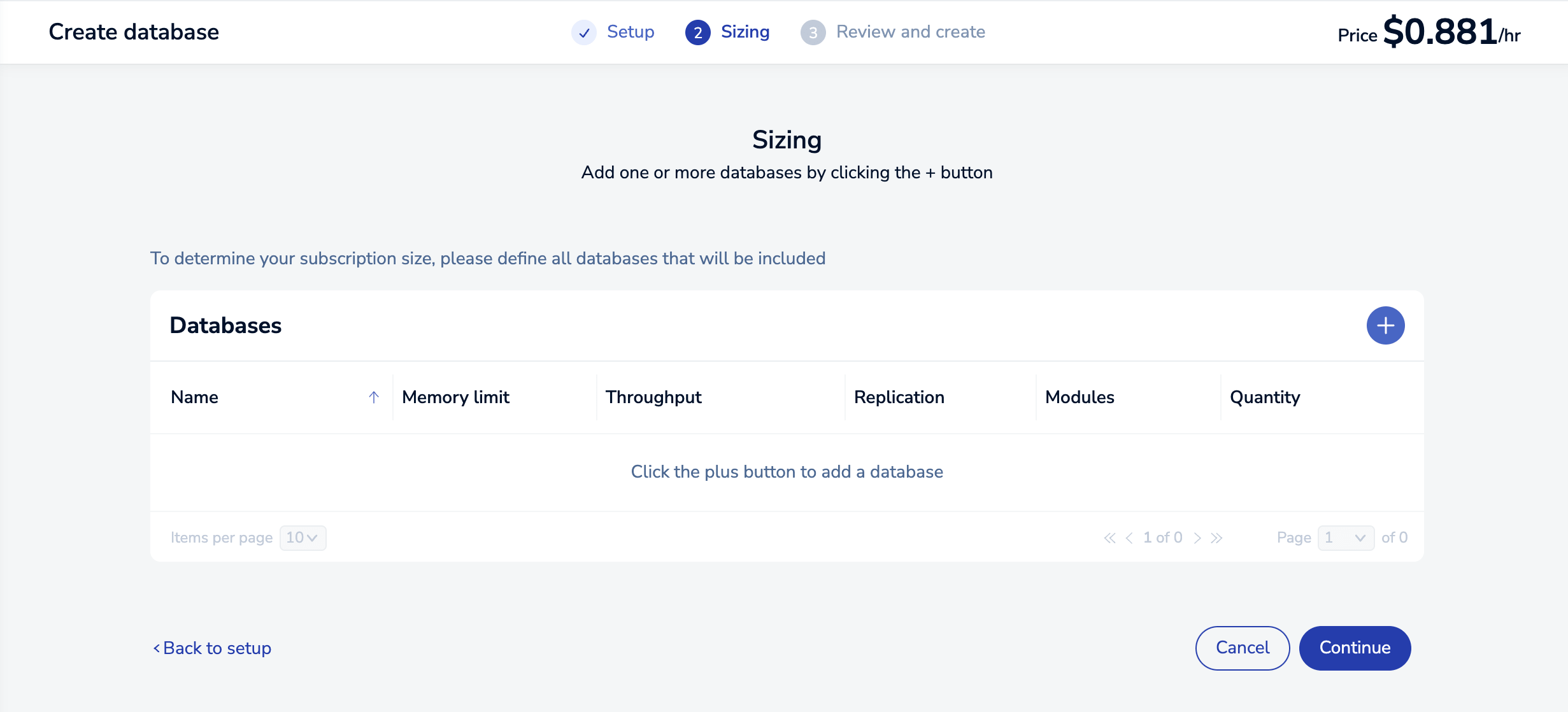
When you first visit the Sizing tab, there are no databases defined. Select the Add button to create one.
This opens the New Database dialog, which lets you define the requirements for your new database.
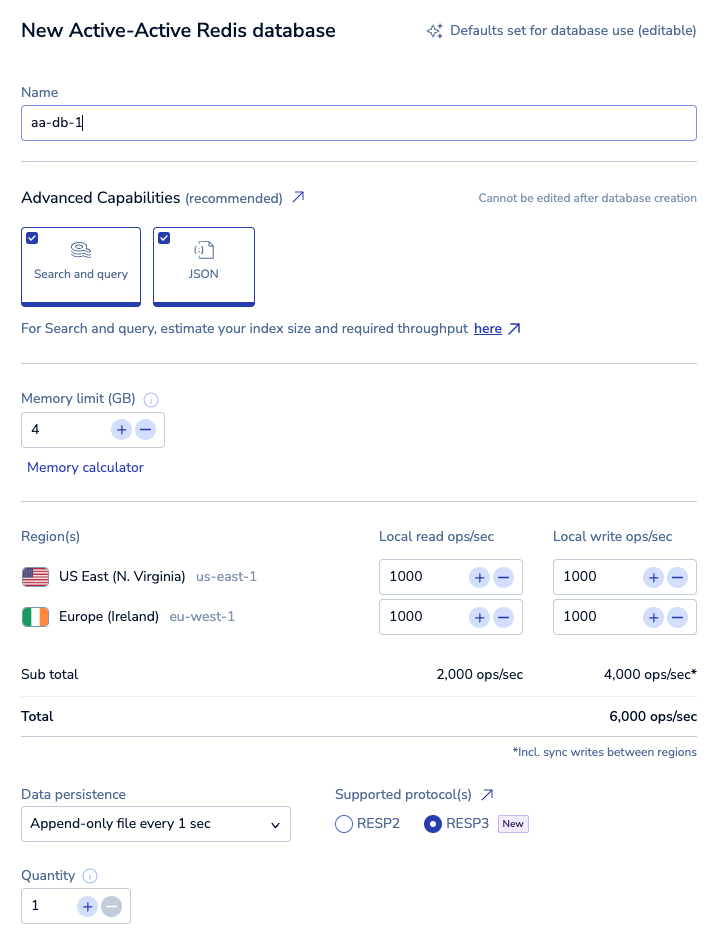
By default, you're shown basic settings, which include:
-
Name: A custom name for your database.
-
Advanced Capabilities: Advanced data types or capabilities used by the database. Active-Active databases support the JSON data type and Search and query capabilities.

We select both capabilities for you automatically. You can remove a capability by selecting it. Selected capabilities will be available in all regions, including those added in the future.
See Search and query Active-Active databases to learn how to use Search and query on Active-Active databases.
-
Dataset size: The amount of data needed for your dataset in GB.
For Search and query databases, use the Sizing calculator to estimate your index size and throughput requirements. When you're entering the dataset size for your database, add the estimated index size from the Sizing calculator to your expected dataset size.
-
Throughput: When you create an Active-Active database, you define the throughput for each instance. The total operations per second combines the total read ops/sec and applies the write ops/sec for each region across every region.
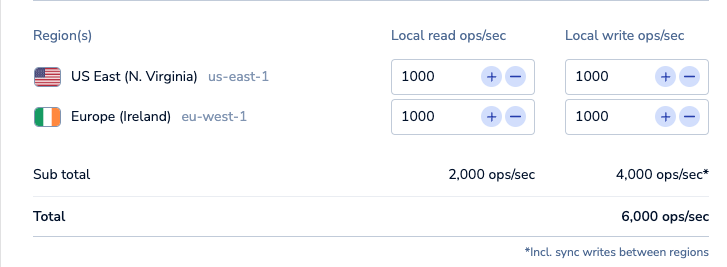
Because each instance needs the ability to write to every other instance, write operations significantly affect the total, as shown in the following table:
Number of regions Read operations Write operations Total operations Two 1,000 each 1,000 each 6,000
(2,000 reads; 4,000 writes)Two 1,500 each 1,000 each 7,000
(3,000 reads; 4,000 writes)Two 1,000 each 1,500 each 8,000
(2,000 reads; 6,000 writes)Three 1,000 each 1,000 each 12,000
(3,000 reads; 9,000 writes)For Search and query databases, the estimated throughput from the Sizing calculator is the total amount of throughput you need. When setting throughput for your Active-Active database, use the total amount for each region and divide it depending on your read (query) and write (update) needs for each region. For example, if the total amount of throughput needed is 50000 ops/sec, you could set each region to have 20000 ops/sec for reads (queries) and 30000 ops/sec for writes (updates).
-
Data Persistence: Defines the data persistence policy, if any. See Database persistence.
-
Supported Protocol(s): Choose between RESP2 and RESP3 (Redis 7.2 only). See Redis serialization protocol for details.
-
Quantity: Number of databases to create with these settings.
When finished, select Save configuration to save your database configuration.

Use the Add database button to define additional databases or select the Continue button to display the Review and create tab.
Hover over a database to see the Edit and Delete icons. You can use the Edit icon to change a database or the Delete icon to remove a database from the list.
Review and Create tab
The Review and Create tab provides a cost estimate for your Redis Cloud Pro plan:
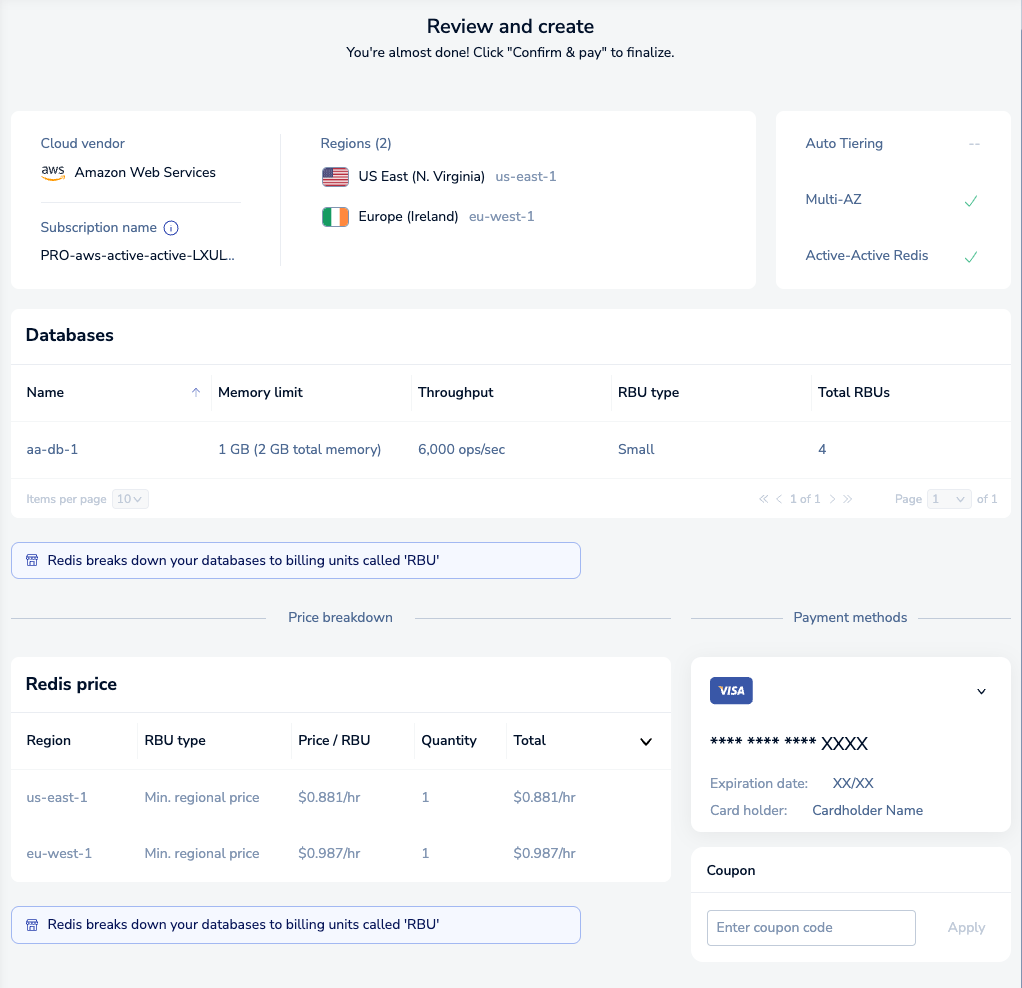
Redis breaks down your databases to Redis Billing Units (RBUs), each with their own size and throughput requirements. For more info, see Billing unit types.
Select Back to Sizing to make changes or Confirm & Pay to create your databases.

Note that databases are created in the background. While they are provisioning, you aren't allowed to make changes. This process generally takes 10-15 minutes.
Use the Database list to check the status of your databases.